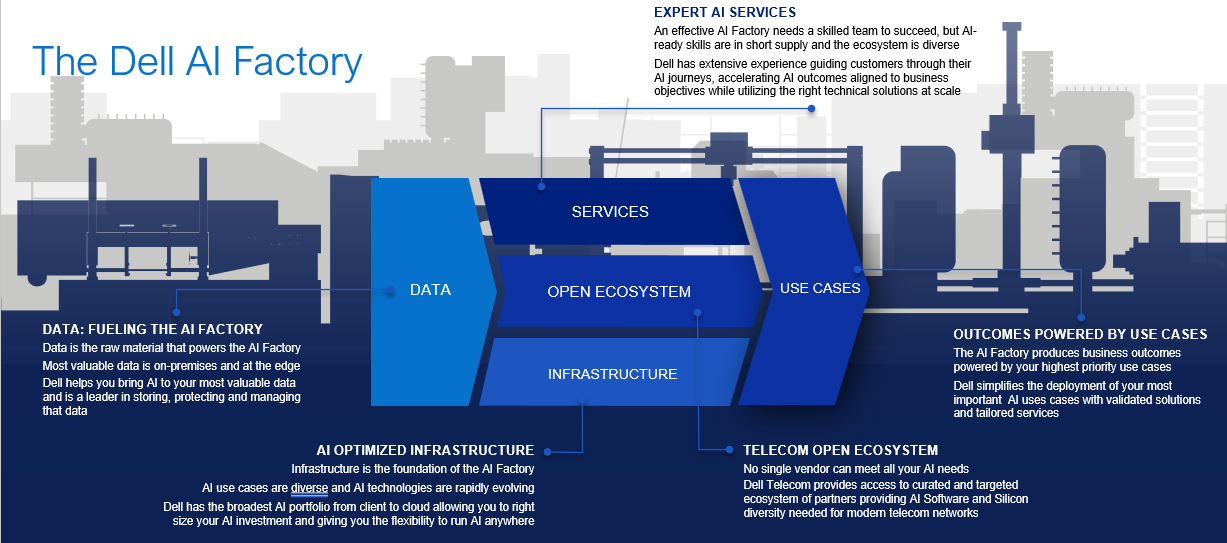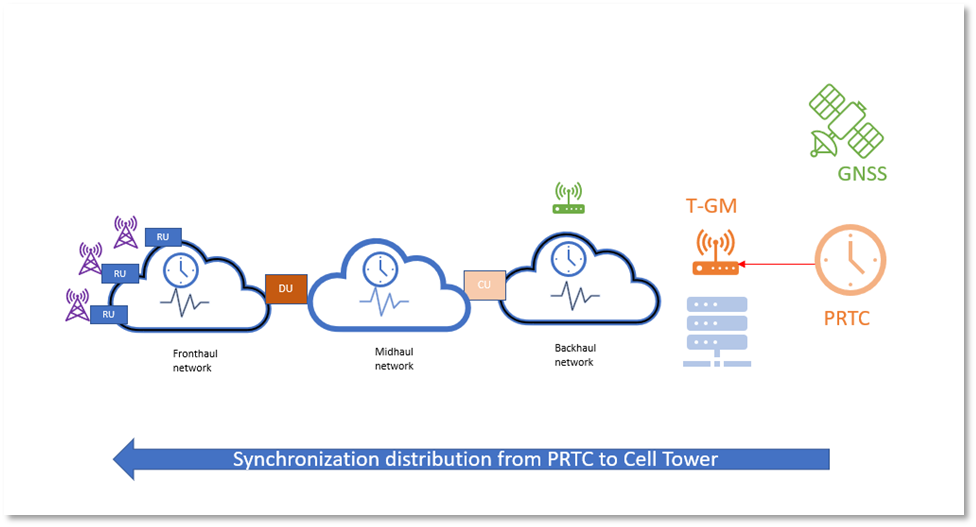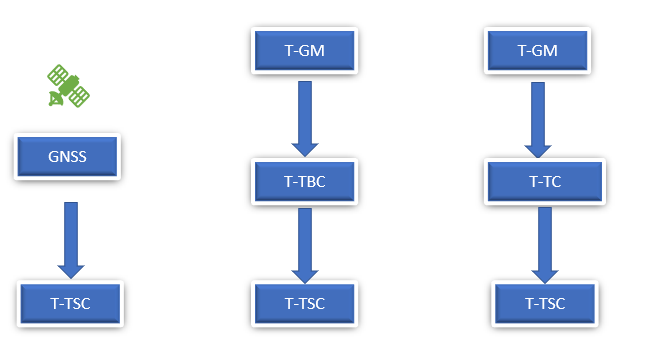Assets

Redefining Telecom with Dell AI: The Future Starts with Dell AI for Telecom
Wed, 02 Oct 2024 10:52:20 -0000
|Read Time: 0 minutes
We are entering a transformational phase with AI and Gen AI. In a recent survey of the state of AI, 65% of organizations have confirmed “regularly using Gen AI” with over 50% of those organizations using Gen AI in at least two business functions[1]. It is estimated that by 2025, two thirds of businesses will leverage a combination of generative AI and Retrieval Augmented Generation RAG to power domain-specific self-service knowledge discovery, to improve decision efficacy by 50%.[2] But this transformation is fraught with challenges, such as skills gap, data and model security, and governance, as well as the cost of running these large language models (LLMs). It is also clear that quality data is a differentiator for Gen AI effectiveness. Any AI model is only as good as the data that feeds and trains it. Critical functions include data prep and formatting, mass storage, protection, accessibility, bandwidth, protection, and recovery.
There’s a need to rethink everything as the current data center and IT operating model are not equipped to cope with the speed and scale of AI, nor are they built to capture the full potential of AI. What’s needed is a new type of data center that is purpose-built to meet the specific demands of AI – this is the AI factory.
Just as physical factories fueled the industrial revolution, AI factories will power the AI revolution. Instead of physical goods, the AI factory produces actionable intelligence, fresh content, and new insights. The AI factory is the new paradigm, and infrastructure is the foundation that makes AI possible.
At Dell Technologies World 2024, we announced the Dell AI Factory, which represents Dell’s approach for embracing and implementing AI. This approach entails helping customers accelerate their AI initiatives and addressing their most pressing challenges with a collection of AI technologies, an open ecosystem of partners, validated and integrated solutions, and expert services to achieve AI outcomes faster.
The need for data security, cost savings, and compliance with government and local sovereignty regulations presents a significant opportunity for Telecom providers and their partnerships with enterprise businesses. With more than 50% of enterprise data generated at the edge and huge amounts of network data aggregated in Telco data centers, much of the data that fuels AI and Gen AI outcomes resides on-premises, highlighting the growing importance of secure, localized solutions.
We are launching Dell AI for Telecom: a family of Dell PowerEdge GPU-enabled servers, data management/storage platforms, and networking to address this transformational evolution together with our ecosystem partners.
Dell AI Factory
With AI-optimized infrastructure as the foundation and PowerEdge servers equipped with GPUs from Nvidia, the Dell AI Factory is open and modular allowing customers the ability to right-size the infrastructure and to expand the infrastructure for growth to meet their business needs. The Dell AI Factory is comprehensive, including Dell PowerEdge GPU servers, network switching fabrics, storage devices, Nvidia AI Enterprise software suite, and Dell professional services for a complete AI Factory infrastructure package.

As the processing of AI data moves closer to the data source, Dell has developed an AI Factory portfolio for every use case. Nvidia L4, L40s, H100, H200, and coming soon the Blackwell family of GPUs are available in the Dell AI Factories to address the need for the right use case with the right GPU. Complementing the GPU offering, Dell AI Factory is based on our PowerEdge server infrastructure which ranges from the PowerEdge XE9680 with the H100 and H200 GPUs for larger model training, inferencing, fine tuning environments to the PowerEdge R760xa with the L40S GPUs for mid-sized model training, inferencing, fine tuning, and video processing applications. As we move closer to the far edge, Dell complements the AI Factory offering with our AI Optimized PowerEdge XR8000 Configurations with Nvidia, suitable for network-centric use cases critical for telecom operators.
The XR8000 server platform is a ruggedized, short depth, modular SLED based platform supporting Nvidia L4 GPUs. It is ideal for the remote zero-touch edge locations where the data resides, or for latency-sensitive applications.
Networking and Storage
In the era of Gen AI, the role of networking and storage infrastructure is more critical than ever. Network switching fabrics are an integral component of an AI Factory because extremely low latency, congestion control, and minimal hops are switching fabric attributes required to deliver the best AI/Gen AI experience. There are three main switching fabrics in an AI Factory:
- The GPU-to-GPU fabric that connects all GPUs and allows them to communicate during training, inferencing, and tuning of LLMs.
- The Storage switching fabric that connects high-performance, scalable, and low latency storage devices to the GPU server platform. Storage is important for a process called “checkpointing” during LLM training. Checkpointing involves storing the current state of a LLM model during training which allows the training process to recover from an interruption and resume training.
- The management fabric that includes both In-band (IB) and Out-of-band (OOB) communications.
Historically, InfiniBand has been the dominant networking fabric in large-scale AI clusters, particularly because of its high data transfer rates, congestion control, and ultra-low latency. These attributes make it ideal for high-performance computing (HPC) and GenAI applications.
However, Ethernet is starting to gain traction in these high-performance environments, especially with the efforts of the Ultra Ethernet Consortium (UEC), a group focused on developing an Ethernet stack tailored for AI and HPC workloads. Dell Technologies is a member of UEC, contributing to innovations that will advance AI infrastructures.
In terms of storage, the Dell PowerScale storage platform is certified for optimal performance in Nvidia GPU-based AI Factories. It scales from a few terabytes to many petabytes and is the primary storage platform used in the Dell AI Factory.
Dell Validated Designs
The Dell AI Factory portfolio is based on Dell Validated Designs (DVDs) which simplify AI with engineering-validated solutions that accelerate deployment of AI models faster. Dell customers benefit from a DVD in that precious engineering resources can be spent developing and moving AI models into production rather than dealing with infrastructure, deployment, and monitoring, and system troubleshooting.
AI at Edge:
Artificial Intelligence at the edge is driving a new wave of operational efficiency and innovation for telcos and enterprises. The Dell XR8000, powered by Intel Sapphire Rapids processors and Nvidia L4 GPUs, delivers robust capabilities for edge AI deployments in private networks and enterprises. As part of Dell’s broader AI ecosystem, the XR8000 enables seamless integration into AI factories, whether for large-scale management clusters or smaller, focused deployments. With its ruggedized design and flexibility, the XR8000 is positioned to enhance operations, generate new revenue streams, and provide valuable services in edge computing environments.
Transforming Telecommunications with Dell AI Factory with Nvidia
Use cases are the driving force and often one of the main motivations behind many of the technology investments that an enterprise makes. AI and GenAI, including AI Factories, have unlocked many use cases spanning both Network NW operators and their end customers. AI and GenAI improve the NW performance, improve the productivity of NW operations, and help to meet revenue targets for NW operators. AI and Gen AI also improve the end subscriber experience by delivering personalized customer experiences. In the sections below we will discuss use cases targeting Telcom network operations and efficiency including CoPilot, Network Digital Twins, and enhanced customer experience.
Network Engineer CoPilot with Kinetica
Dell Technologies is partnering with Kinetica to deliver the Network Engineer CoPilot use case, leveraging the power of GenAI to transform troubleshooting in complex 5G Core and RAN environments. These networks produce vast amounts of data, making it difficult for engineers to quickly pinpoint the root causes of failures. Manual troubleshooting is often time-consuming, error-prone, and too slow for real-time network operations.
With Network Engineer CoPilot, fault management is automated using telco-specific large language models (LLMs) that analyze data in real time. The system detects anomalies, predicts potential failures, and recommends corrective actions, enabling a much faster and more accurate automated Root Cause Analysis (RCA) Identification process. This dramatically reduces troubleshooting time, ensuring network issues are resolved efficiently and with minimal downtime.
In addition to reducing troubleshooting time, proactive AI interventions help improve call quality by detecting and resolving issues before they impact users. This results in enhanced customer satisfaction, better network performance, and improved operational efficiency. Dell Technologies supports this solution with its high-performance PowerEdge R760XA, XR8000, and XE9680 GPU-enabled servers, which are specifically designed to handle the demanding computational needs of real-time data analysis in 5G environments.
Network Digital Twins with Synthefy– Predictive Planning and Efficiency
Dell Technologies is partnering with Synthefy to advance the Network Digital Twin use case. Telecom networks generate massive amounts of data from switches, routers, and access points, making real-time analysis complex. Generative AI (GenAI) addresses this challenge by creating Network Digital Twins—virtual models that replicate both physical and software-defined components of the network. These digital twins enable telecom operators to simulate network conditions, test upgrades, and predict failures using realistic synthetic data, all without disrupting live operations. This results in more efficient decision-making and improved network optimization.
Synthefy provides the sophisticated AI Engine software for the digital twins, while Dell’s advanced GPU-enabled servers, such as the XE9680, and scalable storage solutions like Dell PowerScale, offer the robust infrastructure required to support these AI-driven simulations. Dell’s infrastructure excels in handling large and diverse datasets, including the time series, logs, and PCAP files that are essential for high-performance simulations. By integrating Synthefy software with Dell’s infrastructure, we simplify the creation of digital twins, reduce operational costs, and enhance network resilience and adaptability to future demands.
Enhanced CSP Operations and Customer Engagement with Amdocs
Together with Amdocs amAIz GenAI suite and Dell Technologies’ advanced infrastructure with Nvidia GPUs, we are targeting the next-generation customer service and CSP operations. Amdocs' amAIz Copilots seamlessly integrate with telecom systems to deliver industry-specific AI assistants that provide contextual, accurate, and trustworthy responses to customer queries, while also automating complex tasks. This collaboration promises to:
- Improve customer service with intelligent AI-driven Copilots
- Enhance efficiency through automation of complex tasks
- Streamline operations and reduce operational costs
Dell’s PowerEdge XE9680 and R760XA servers, equipped with Nvidia GPUs, offer the necessary computational power for training and deploying large language models. Dell PowerScale storage ensures high-speed access to essential datasets, while Dell Networking solutions guarantee low-latency data transfers. Together, these technologies enable telecom operators to deploy scalable, high-performance GenAI solutions, transforming customer interactions and optimizing service delivery.
Summary and Conclusion:
At Dell Technologies, we are committed to advancing AI and Generative AI with our Telecom partners. Our AI Factory delivers scalable solutions with PowerEdge GPU servers, network switching, and high-performance storage, tailored specifically for efficient, localized AI deployment.
If optimizing your AI infrastructure and enhancing data security are priorities for your organization, consider Dell's AI Factory for your next project. The potential for innovation and efficiency is vast, and our solutions are designed to make it accessible. Get started with Dell Technologies today and explore how our Dell AI Factory can support your journey into the next era of AI-driven telecommunications. To learn more or to begin your integration, contact your Dell account representative or join our partner program.
References:
[1] https://www.mckinsey.com/capabilities/quantumblack/our-insights/the-state-of-ai

PTP and SyncE on Dell Next-Generation Servers
Fri, 03 Mar 2023 19:57:24 -0000
|Read Time: 0 minutes
Summary
The telecom industry is on a journey of transformation, making pitstops to disaggregate hardware and software, virtualize networks, and introduce cloudification across RAN and core domains. The introduction of 5G and ORAN has accelerated the transformation, and we now see telecom becoming a universal phenomenon and touching all aspects of life.
This telecom evolution opened a number of opportunities for CSPs to diversify their revenue streams, but it also introduced stringent technological implementations. To support higher bandwidth and mMIMO technologies in new-generation systems, solution development teams were faced with strict requirements of latency and synchronization.
In this tech note, we discuss synchronization systems in 5G and ORAN fronthaul interfaces, and next-generation Dell PowerEdge support for synchronization standards.
Note: This document may contain language from third-party content that is not under Dell Technologies’ control and is not consistent with current guidelines for Dell Technologies’ own content. When such third-party content is updated by the relevant third parties, this document will be revised accordingly.
Network synchronization
Telecom networks have always required proper and accurate synchronization for handover between different cell sites, reducing interference and increasing performance at cell edge. 2G, 3G, and 4G networks all required a certain level of synchronization, but 5G requires timing in the range of nanoseconds. This enables features such as beamforming and time-division duplexing to function accurately.
Telecom systems generally work based on the following synchronization methods:
- Frequency synchronization: Frequency synchronization ensures that the frequency of the local clock at the 5G/4G cell site is the same as the PRTC. The quality of frequency synchronization is measured in parts per billion (ppb) by the difference between the actual and desired frequency.
- Time synchronization: Time synchronization refers to the distribution of time across clocks in a network. Time synchronization is one way of achieving phase synchronization.
- Phase synchronization: Phase synchronization takes care of the timing signals occurring at the same time. It ensures that the rising edge of each clock input occurs at the same time. The quality of phase synchronization is measured in microseconds (ms) or nanoseconds (ns) by the difference between the timing of the signals.
The following table lists the telecom requirements for the frequency and phase specifications:
Table 1. Telecom technologies with standard units
Telecom technology | Frequency air interface/network | Phase/time air interface/network |
GSM | 16 ppb/50 pbb | - |
LTE-FDD | 16 ppb/50 ppb | - |
LTE-TDD | 16 ppb/50 ppb | 1500 ns |
LTE-A | 16 ppb/50 ppb | 500 ns |
5G | 16 ppb/50 ppb | 65 ns |
Methods of synchronization transmission
Different standards apply to the transmission of the synchronization signals, as outlined in the following table:
Table 2. Synchronization methods for distribution standards
Synchronization distribution standard | Time synchronization | Frequency synchronization | Phase synchronization |
PTP (IEEE 1588) | Yes | Yes | Yes |
SyncE | No | Yes | No |
GNSS | Yes | Yes | Yes |
NTP | Yes | Yes | Yes |
Fronthaul synchronization requirements for 5G in ORAN
O-RAN ALLIANCE has defined four synchronization topologies— LLS-C1 , LLS-C2 , LLS-C3 and LLS-C4—to address different deployment topologies in telecom networks. The following figure shows a typical synchronization flow diagram with synchronization from PRTC flowing to end cell sites:

Figure 1. ORAN synchronization overview
PRTC: Primary Reference Time Clock
GNSS: Global Navigation Satellite System
T-GM: Telecom Grand Master Clock
Stay tuned for another tech note from Dell with more details about synchronization technologies.
In telecom systems, synchronization is delivered by various mechanisms:
- Synchronization signals are delivered from GNSS directly to each node in the network. This system is accurate, but it becomes quite costly.
- Synchronization signals are delivered from a centralized PRTC/T-GM in-band over a transport network.
- Synchronization signals are delivered by a dedicated synchronization transport network that is separate from the transport network used to carry user and control signals.
The transport network for carrying synchronization can be either the backhaul network used to carry traffic or a dedicated network for transporting synchronization signals.
In 5G and ORAN, gNBs need frequency, phase, and time synchronization. The following two protocols are used for transporting synchronization signals over a packet-based network:
- Precision Time Protocol (PTP)
- Synchronous Ethernet (SyncE)
The same packed-based transport network can be used to carry users and control plane traffic.
PTP
PTP, defined by the IEEE 1588 standard, was developed to provide accurate distribution of time and frequency over a packet-based network. A PTP synchronization system is composed of PTP-aware devices and non-PTP-aware devices.
The following table describes the clock types in PTP:
Table 3. Types of clocks in PTP
Clock type | Definition | Usage |
Telecom grandmaster (T-GM ) | The master clock at the start of a PTP domain. It is typically located at the core network. | At the beginning of the network to provide timing signals to network. |
Telecom boundary clock (T-BC) | Clock that can act both as a slave and master clock. It takes the sync signal from the master, adjusts for the delay, and generates a new master synchronization signal to pass downstream to the next device. | When the synchronization signal needs to travel through multiple nodes across a long distance. |
Telecom transparent clock (T-TC) | Clock that timestamps a synchronization packet message and sends it forward to the secondary device. It enables the secondary device to calculate the delay of the network. | For scenarios where timing signals are passing through switches. |
Telecom time slave clock (T-TSC) | The end device that receives the synchronization signal. | In telecom, the end node that receives the synchronization signals. |
The following figure illustrates how various types of clocks in PTP interact with each other:

Figure 2. Types of clocks in PTP
In 5G and ORAN, PTP generally works with two types of timing profiles, G8275.1 and G8275.2 . As shown in the following figure, G8725.1 is the profile where all devices are PTP-aware devices, and G8275.2 is the profile where are all devices can be, but might not be, PTP-aware devices.  Figure 3. G8275.1 and G8275.2 timing profiles
Figure 3. G8275.1 and G8275.2 timing profiles
Why do ORAN and 5G need two PTP profiles? One reason is the use case and implementation perspective of the CSP, as outlined in the following table:
Table 4. PTP telecom profiles
PTP Telecom Profile | Description | Usage |
G8275.1 (full timing support) |
|
|
G8275.2 (partial timing support) |
|
|
SyncE
SyncE is a synchronization technology that enables the transfer of synchronization signals at the physical layer. It is used to provide accurate and stable frequency synchronization between the different components of a network architecture. Over the fronthaul interface in ORAN and 5G, both SyncE and PTP are used together to provide nanosecond-level synchronization accuracy. SyncE can deliver frequency synchronization, but it cannot deliver phase and time synchronization. It functions independently of the network load and supports the transfer of sync signals where all the interfaces on the intermediate path must support SyncE.
Why fronthaul synchronization requires both PTP and SyncE
In ORAN, for topology architectures LLS-C1, LLS-C2, and LLS-C3, both SyncE and PTP are used on the fronthaul interface between DU and RU or in the mid-haul interface between CU and DU. When PTP itself can cater to frequency, time, and phase synchronization, why do we need SyncE along with PTP?
The answer is that using both PTP and SyncE delivers these advantages:
- Higher accuracy: SyncE is a physical layer protocol that can deliver a stable and consistent frequency. Combining the stability of SyncE for frequency synchronization with the precision of PTP for time and phase synchronization provides for a very accurate clock.
- High availability: When a PTP clock fails, the node can fall back to the SyncE frequency clock and advance the time more accurately and for longer, rather than relying only upon the internal oscillator. Also, when the PTP clock source fails, locking to a new PTP source can occur quickly when SyncE is already in use. Without SyncE, PTP can take more time to identify the actual time and lock to a new clock source.
Implementation of PTP and SyncE in next-generation PowerEdge servers for telecom applications
Next-generation Dell PowerEdge servers come with Intel NIC cards such as Westport Channel and Logan Beach. All these NIC cards are timing aware and can be used to provide synchronization to downstream nodes. Because these servers can be positioned both as CU and DU, and support LLS-C1 , LLS-C2, and LLS-C3 deployment, support of SyncE and PTP makes these servers an apt choice for RAM and edge deployments.
Conclusion
Dell Technologies continues to provide best-in-class features and specifications for its constantly evolving PowerEdge server portfolio for telecom. The PowerEdge XR8000 (430 mm depth) and XR5610 (463 mm depth) provide scalability and flexibility, with the latest technologies for PCIe, storage, memory, I/O, and even node-chassis infrastructure in a dense (SA1) form factor. With support for PTP and SyncE technologies, these next-generation PowerEdge servers provide essential infrastructure support at the edge.


